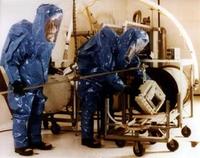-
U.S. inspects only 2 percent of all imported food
Each year one in six Americans — 48 million people — gets sick, 128,000 are hospitalized, and 3,000 die from foodborne diseases; the FDA uses a risk-based system to isolate foods with high risk of contamination, but physically inspects only about 2 percent of all imported food
-
-
Millions of yet-to-be-described viruses found in raw sewage

There are roughly 1.8 million species of organisms on planet Earth, and each one is host to untold numbers of unique viruses, but only about 3,000 have been identified to date; a new study reveals a vast world of unseen viral diversity that exists right under our nose — in ordinary raw sewage, to be precise
-
-
Report: anthrax antibiotic should be stockpiled locally
A new report describes a plan for the United States to be better prepared in the event of a bioterrorist attack using anthrax; the report recommends that public health officials in high-risk areas should consider stockpile anthrax antibiotics in local locations to make it easier to dispense quickly to an area of need, rather than continuing to use the single national stockpile
-
-
Contaminated cantaloupe outbreak deadliest in decade

The recent listeria outbreak that has sickened seventy-two people and killed as many as sixteen, is shaping up to be the deadliest U.S. food-borne disease outbreak in more than a decade
-
-
Elusive killer parasite being traced in Peru
Chagas disease, primarily seen in South America, Central America, and Mexico, is the most deadly parasitic disease in the Americas; Penn epidemiological study takes snap shot of long-term Chagas disease outbreak
-
-
Real-time disease monitoring can help improve diagnoses
Discovering epidemics or knowing when one is brewing is particularly difficult at the local level as doctors lack a broader perspective of what is occurring; to help provide local doctors with better information that could help stem the spread of infectious diseases, public health officials are pushing for the creation of a real-time national disease monitoring system
-
-
Study finds traces Japanese radiation in U.S. rain and food
A recently published government study found that following the nuclear accident at the Fukushima Daiichi power plant in Japan, elevated levels of radiation were detected in U.S. rain water as well as vegetables and milk
-
-
Japanese attenuated smallpox vaccine shows promise in U.S. trial
An attenuated smallpox vaccine that was developed in Japan in the 1970s compared well with a conventional smallpox vaccine in a phase 1-2 clinical trial in the United States
-
-
FDA unveils new outbreak response network

Last week, the U.S. Food and Drug Administration unveiled its new streamlined approach for responding to foodborne illness outbreaks; under the “CORE” Network, the FDA Coordinated Outbreak Response and Evaluation Network, the FDA will bring together multidisciplinary teams consisting of epidemiologists, veterinarians, microbiologists, environmental health specialists, emergency coordinators, and risk communications specialists
-
-
Mapping the spread of drug-resistant influenza

The movie “Contagion” is not based on real events, but it is not science fiction, either: certain strains of influenza are becoming resistant to common treatments; a team of researchers map out how this phenomenon is happening globally
-
-
Budget cuts could hurt biodefense efforts

With lawmakers struggling to reduce spending and cut the deficit, funding for government programs aimed at thwarting biological threats could face severe budget cuts; while the budget for overall civilian biodefense increased by 17 percent, that number is deceiving as federal agencies consolidated and combined several key programs under larger budget line item headings
-
-
Biological weapons: U.S. must not repeat the failure of imagination
Joel McCleary, a biological weapons expert, is the chairman and co-founder of Q Global and the founder of PharmAthene; he argues that the U.S. government has not done enough to protect the nation against a biological attack, warns of the need for presidential leadership, and underscores the dangers of biological weapons
-
-
Emergency medical response in a post-9/11 Washington, D.C.
Beverly Pritchett, the senior deputy director of the Health Emergency Preparedness and Response Administration at the D.C. Department of Health, is a 27-year veteran of the U.S. Army Medical Service Corps; Pritchett discusses improvements made to the city’s emergency medical response capabilities, the integration of smartphones and social media into disaster response plans, and the need for continued funding to sustain the gains made in public health over the past ten years
-
-
Simple solution for removing arsenic from water

Almost 100 million people in developing countries are exposed to dangerously high levels of arsenic in their drinking water, unable to afford complex purification technology; scientists developed a simple, inexpensive method for removing arsenic based on chopped up pieces of ordinary plastic beverage bottles coated with a nutrient found in many foods and dietary supplements
-
-
Scientists "domesticate" -- and disarm -- malaria parasite
Malaria is one of the Earth’s most notorious scourges, accounting for more than 250 million new cases — and one million deaths — each year, researchers have developed a novel technique to “tame” the malaria parasite by forcing it to depend on an external supply of a vital chemical; this could help to speed up drug development and provide the basis for the first effective vaccine against malaria
-
More headlines
The long view
Ransomware Attacks: Death Threats, Endangered Patients and Millions of Dollars in Damages
By Dino Jahic
A ransomware attack on Change Healthcare, a company that processes 15 billion health care transactions annually and deals with 1 in 3 patient records in the United States, is continuing to cause massive disruptions nearly three weeks later. The incident, which started on February 21, has been called the “most significant cyberattack on the U.S. health care system” by the American Hospital Association. It is just the latest example of an increasing trend.
